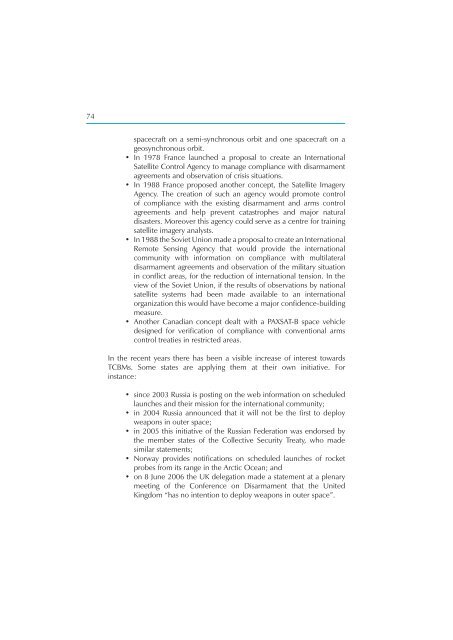Security in Space The Next Generation - UNIDIR
Security in Space The Next Generation - UNIDIR
Security in Space The Next Generation - UNIDIR
You also want an ePaper? Increase the reach of your titles
YUMPU automatically turns print PDFs into web optimized ePapers that Google loves.
74<br />
spacecraft on a semi-synchronous orbit and one spacecraft on a<br />
geosynchronous orbit.<br />
In 1978 France launched a proposal to create an International<br />
Satellite Control Agency to manage compliance with disarmament<br />
agreements and observation of crisis situations.<br />
In 1988 France proposed another concept, the Satellite Imagery<br />
Agency. <strong>The</strong> creation of such an agency would promote control<br />
of compliance with the exist<strong>in</strong>g disarmament and arms control<br />
agreements and help prevent catastrophes and major natural<br />
disasters. Moreover this agency could serve as a centre for tra<strong>in</strong><strong>in</strong>g<br />
satellite imagery analysts.<br />
In 1988 the Soviet Union made a proposal to create an International<br />
Remote Sens<strong>in</strong>g Agency that would provide the <strong>in</strong>ternational<br />
community with <strong>in</strong>formation on compliance with multilateral<br />
disarmament agreements and observation of the military situation<br />
<strong>in</strong> confl ict areas, for the reduction of <strong>in</strong>ternational tension. In the<br />
view of the Soviet Union, if the results of observations by national<br />
satellite systems had been made available to an <strong>in</strong>ternational<br />
organization this would have become a major confi dence-build<strong>in</strong>g<br />
measure.<br />
Another Canadian concept dealt with a PAXSAT-B space vehicle<br />
designed for verifi cation of compliance with conventional arms<br />
control treaties <strong>in</strong> restricted areas.<br />
In the recent years there has been a visible <strong>in</strong>crease of <strong>in</strong>terest towards<br />
TCBMs. Some states are apply<strong>in</strong>g them at their own <strong>in</strong>itiative. For<br />
<strong>in</strong>stance:<br />
s<strong>in</strong>ce 2003 Russia is post<strong>in</strong>g on the web <strong>in</strong>formation on scheduled<br />
launches and their mission for the <strong>in</strong>ternational community;<br />
<strong>in</strong> 2004 Russia announced that it will not be the fi rst to deploy<br />
weapons <strong>in</strong> outer space;<br />
<strong>in</strong> 2005 this <strong>in</strong>itiative of the Russian Federation was endorsed by<br />
the member states of the Collective <strong>Security</strong> Treaty, who made<br />
similar statements;<br />
Norway provides notifi cations on scheduled launches of rocket<br />
probes from its range <strong>in</strong> the Arctic Ocean; and<br />
on 8 June 2006 the UK delegation made a statement at a plenary<br />
meet<strong>in</strong>g of the Conference on Disarmament that the United<br />
K<strong>in</strong>gdom “has no <strong>in</strong>tention to deploy weapons <strong>in</strong> outer space”.








